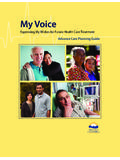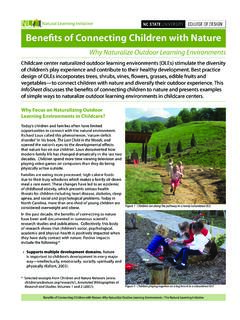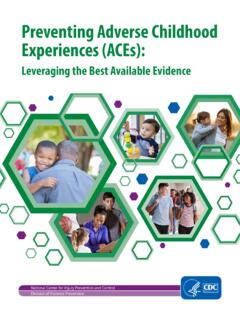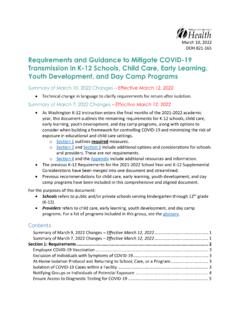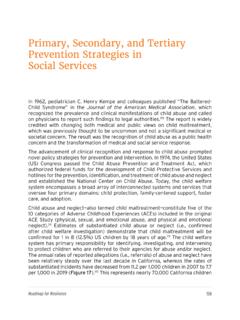Transcription of Furnishings & Equipment Guidelines for Licensed Child Care ...
1 Furnishings & EquipmentGuidelines forLicensedChild care FacilitiesBCHealthPlanningFurnishings & EquipmentGuidelines forLicensedChild care FacilitiesDeveloped byUnit for Child care ResearchSchool of Child and Youth CareUniversity of VictoriaandCommunity care Facilities Licensing ProgramVancouver Island Health AuthorityCopies of this publication may be obtained fromyour local Health Authority or at the following website: Cataloguing in Publication DataMain entry under title: Furnishings & Equipment Guidelines for Licensed Child care facilitiesISBN 0-7226-3131-X1. Day care centers - British Columbia - Equipment and supplies. of Victoria ( ). Unit for Child care Research. Columbia, Community care Facilities Branch. III. Capital( ). Health Dept. IV. British Columbia. Ministry of Health andMinistry Responsible for 1997 2 09711 C97-960003-0 Table of ContentsAcknowledgements.
2 1 Introduction.. 2A. Equipment for Developmental Needs.. 3 Setting Priorities.. 3 Licensing Requirements: An Overview.. 3 Creating Environments for Integrated Learning.. 4 Developmentally Appropriate Practice.. 5B. Using the Guidelines .. 6 How are the Guidelines Organized?.. 6 How Much Equipment is Enough?.. 6 Applying the Guidelines .. 7 Equipment for Infants, Toddlers, and School Age children .. 8C. Furnishings & Equipment Guidelines .. 9 Routine care .. 9 Physical Development.. 12 Intellectual Development.. 19 Language Development.. 27 Emotional Development.. 30 Social Development.. 33D. Using Space Effectively.. 36 Arranging Space.. 36 Space Plans.. 38 Storage.. 41E. Dollar Smart Choices.. 42 Think Before You Buy.. 42 The Frugal care Provider.. 42 Additional Resources.. 43 AcknowledgmentsAn Advisory Committee made up of representatives from licensingand Licensed Child care programs provided guidance and input to thisproject.
3 The following individuals are gratefully acknowledged fortheir role in developing this booklet and the accompanying checklists: Peggy Acomba, Ministry of Women s Equality, Child care Branch Dianne Bentley, Carrot Seed Preschool, Victoria Diane Carruthers, Cool Aid Day care Centre, Victoria Shelly Christie, Vancouver/Richmond Health Region, Licensing Southern Vancouver Island Family Day care Association:Ann Didmon, Gloria Maher, Diana McKay, Bren Raiska,Denise Smeaton Mary Jane Kellington, Capital Health Region, Child care Licensing Regional Out-of-School care Operators (ROSCO): Kim Miles,Caren Ward Marcia Thorneycroft, Capital Health Region, Child care LicensingWe wish to thank the staff at the following Child care programs forallowing the Guidelines and checklists to be tested, and photographstaken, in their programs: A Child s Heart & A Child s Dreams Daycare Centre, Victoria Campus View Out Of School Club, Victoria Carrot Seed Preschool, Victoria Cool Aid Day care Centre, Victoria Infant Plus Daycare Centre, Victoria Kermit s Korner Family Day care , Victoria Victoria children s Centre, VictoriaProduction Credits:Research and Writing: Susan Gage, Theresa HunterIllustrations: Caren WardPhotographs: Theresa Hunter, Susan Gage, Ruth Fahlman12 IntroductionAdequate Furnishings and Equipment are essential components ofquality Child care .
4 Child care providers and licensing officers need toshare an understanding of the program requirements for basic andenhanced levels of Furnishings and Equipment . They need to work inpartnership to ensure that all Child care programs provide adequateenvironments that support all areas of children s development andmeet the requirements of the Child care Licensing Regulation. Theseguidelines were developed in order to support this Guidelines recommend both basic and enhanced Furnishings andequipment to meet children s needs in the areas of physical, intellectual,language, emotional, and social development. They also address theneed for toys and materials for tactile, visual and auditory addition to the Guidelines , a number of checklists have been pro-duced to help identify basic Furnishings and Equipment needed for eachtype of Licensed program: All Licensed Child care Programs: Routine care Checklist Group Child care Under 36 Months Group Child care 30 Months to School Age Preschool care Family Child care Child Minding, 18 Months to School Age School Age care (also known as Out of School care )These checklists are available from your local licensing officers, or onthe Community care Facilities website: the Guidelines and ChecklistsTogether these Guidelines and checklists will: provide new applicants and Licensed Child care providers withclearly defined expectations regarding Furnishings and Equipment .
5 Enhance the quality of Child care through well equipped andfurnished Licensed facilities; and serve as an educational resource for licensing staff, Child careproviders and booklet is a companion guide to the publication Program Standardsfor Early Childhood Settings. (See Additional Resources)A. Equipment forDevelopmental NeedsSetting PrioritiesCare providers need to set priorities when choosing Furnishings andequipment. What Equipment does a program really need to be effective?Or, to put it another way, how can Child care providers choose equipmentwhich will support children s development in all areas?Licensing Requirements: An OverviewThe Child care Licensing Regulation, which outlines basic requirementsfor Child care programs in British Columbia is available on theCommunity care Facilities website: may also contact your local licensing officer for help in obtaininga copy or for clarification of the Regulation.
6 The Regulation states:The licensee shall provide, for children enrolled in a facility, acomprehensive and coordinated program of activities that:(a) is designed for the development, care and protection of children ,(b) is appropriate for the age and development of the children ineach group in the facility, and(c) meets the standards set out in Schedule D outlines the required program standards to support children sphysical, intellectual, language, emotional and social development. Anaccompanying document entitled Program Standards for Early ChildhoodSettings (1991) more fully explains the standards, and suggests anumber of program activities to support each one. (To obtain a copy,see page 44 of this booklet.)This booklet provides Guidelines for Furnishings and Equipment tosupport development in five areas: physical, intellectual, language,emotional, and social. By thinking about Equipment from a developmentalperspective, Child care providers can make choices and set prioritieswhich ensure that children in their care will have Equipment andfurnishings to encourage development in all these Environments forIntegrated LearningThe Child care Licensing Regulation defines program standards formeeting children s needs in five areas of development.
7 This bookletuses the five developmental headings as a way to organize the lists ofrecommended Furnishings and of the activities referred to in this booklet may involve more thanone area of children s development. For example, music can cross overmany developmental areas. It can be intellectually stimulating, as childrenlearn to recognize rhythms and tunes. children may learn the words tosongs which will support their language development. Music is oftenvery enjoyable, providing children with an emotional sense of well-being and competency. Music can be a social activity where many childrensing or play instruments together, interacting with one another. children smusic is often accompanied by physical activity or movement, throughwhich children can learn coordination, dances or a series of actions. Whilemusic may be classified under Intellectual Development in the ChildCare Licensing Regulation, it can encompass all areas of Furnishings and Equipment in a Child care program should stimulateall aspects of children s development in a variety of ways.
8 For example,a climbing structure will encourage children to use their large leg, armand back muscles. If the structure has a platform that more than onechild can stand on, then children will be encouraged to socialize. Theway in which the environment is set up will influence how childrenrespond to their environment and the kinds of activities they willengage in, and will thus influence their well-designedclimbingstructuresupportsso cial aswell Appropriate PracticeIn order to meet children s physical, intellectual, language, emotionaland social needs, early childhood programs must be developmentallyappropriate. The National Association for the Education of YoungChildren describes a developmentally appropriate early childhoodprogram as one that is both age appropriate and individualappropriate (Bredekamp, 1987, p. 2).Age appropriateness:Knowledge of typical development of children within the age spanserved by the program provides a framework from which [ Child careproviders] prepare the learning environment and plan appropriateness:Each Child is a unique person with an individual pattern and timingof growth, as well as individual personality, learning style, andfamily background.
9 Both the curriculum and adults interactionswith children should be responsive to individual order to work with young children it is important to understand theprocesses involved in their development. There are many excellentbooks which provide descriptions of typical developmental milestones,behaviours, needs and interests of children at different ages. (SeeAdditional Resources) A course in Child development is highlyrecommended to help Child care providers understand children well as being aware of general milestones in development, it isimportant to be sensitive to the uniqueness of each Child . It may betrue, for instance, that cutting with scissors is an age-appropriateactivity for most 4-year-olds. However, Johnny, who is five, has a lotof difficulty with scissors. Six-year-old Lillian, who has cerebral palsy,can use scissors with the help of special grips. Meanwhile, Jessica,who is three, cuts with Using the GuidelinesHow are the Guidelines Organized?
10 The Guidelines for recommended Furnishings and Equipment outlinedon pages 9 to 35 of this booklet are organized into six sections. Thefirst section deals with Furnishings and Equipment that every Child carefacility must have in order to provide safe, sanitary and well-organizedroutine care for children of all ages. This is followed by five sections,each dealing with one of the five key areas of Child development physical, intellectual, language, emotional, and social the beginning of each of these five sections, the relevant programstandards from the Child care Licensing Regulation are listed. Theneach of the listed standards is dealt with separately, showing differenttypes of Equipment , and specific age groups (Infants & Toddlers, 3 5year-olds, and/or School Age (5 12 years) these types of equipmentare most suitable for. Some materials are shown as suitable for morethan one age example is marked with a if it is a basic piece of Equipment , ora if it is non-basic Equipment recommended to enrich and enhancethe Child care setting.)

